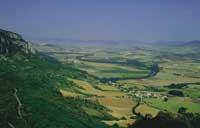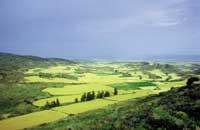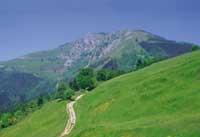Gallina Giant steppe
1997/07/01 Elosegi Irurtia, Migel M. Iturria: Elhuyar aldizkaria
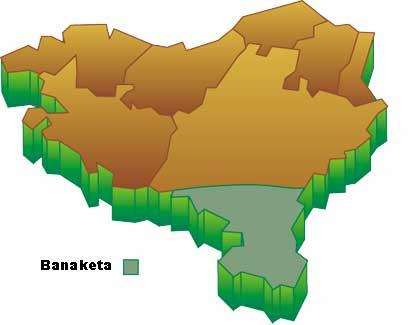
The south wind is soft and the heads, green and green, still dance like the waves. From this ephemeral hill, more than the wheat field, it seems that we are seeing a green sea and the wind makes the flow of the waves constant. In the distance of the plain, several white bodies have been detected that, because of the possibility of being sheep, we have looked with binoculars. Surprisingly, we have realized that sheep are incredible birds, and we have continued to look closely.
Taking the most elegant march, with the head very erect and the tail raised up, when we noticed that the big gigantic males were amazed and suddenly adopt a stance that has made them completely change the appearance of the body. Tilting the head backwards, inflating the air sacks of the neck, opening the wings and raising the feathers and twisting outwards, our male basoilos resemble the white feathered flowers and begin to rotate to attract the eyes of the surrounding females. Faced with this wonderful spectacle, it has given us pain that it has not been beyond, but since we knew the terrible nature of these animals, we have not tried to approach us.
Large glass large glass Species : Otis tarda Family : otidido Order : gruiform Class : birds |
This incomparable wedding dancer, the great vasollo, is a bird that resembles the ostrich. The male is much larger than the female and can have between 8 and 17 kilos of weight. The forest of 15 kilos is undoubtedly the heavier flying bird of the area, but its height width oscillates between 2,2-2,5 meters, being greater in other species. Although the female is much smaller and slender, with a width of wings of 1.7 meters and a weight of 4-6 kilos, it is a large bird. Taking into account the size and place of residence of these animals, anyone can think that it has to be easy to see, but it is not so since, besides being attentive, they have an adequate camouflage. Gray and whitish head and neck, brown back and white lower parts that allow them to lie in the middle of a field and make them practically invisible. The male and the female have a similar coloration, but the first ones are characterized by their chestnut footprint on the chest and by the chin feathers that give shape to mustache in the heat. On the other hand, both sexes have long, robust legs to move better on earth.
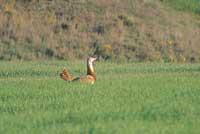
The original habitat of these giants was the areas of recreation and steppes that had not been sown before, but the conversion of human beings into agricultural lands forced the large sketches to adapt to these new habitats. It is possible that the large sketches have a certain diffusion throughout history with the felling of forests and their conversion into fields of cultivation, but, as we will see, some human activities of this last century have provoked the decline of this species.
On the other hand, the sketches are gregarious animals with a complex and changing social organization throughout the year. In winter they join in both sexes and in early spring the males begin to move little by little towards the places of dance. In it, after many struggles and discussions are organized hierarchically and the dominant males are those that equip several females. After the coplas, the females go to spawn in a quiet place and then, next to the chitos, they travel small family groups. In the areas of recreation, large sketches constantly seek food. Despite being mainly herbivores, other small animals such as grasshoppers, beetles, etc., are also disguised.
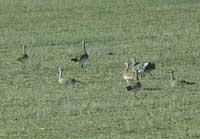
The love period we have described at the beginning extends towards the month of April, and after the wonderful wedding dances the female chooses the favorite male to match it. The female hardly nidifies and deepens at some point of the soil, where she lays 2-3 eggs of olives. After an incubation period of 25-28 days after the birth of the offspring they leave the nest to follow the mother. The offspring are ojival bichos and at first the mother eats to the beak. However, soon the mother begins to catch the bugs and leave them on the ground so that they learn to look for them and does not spend much time until they learn to run like them. After 4-5 weeks they start flying and after about 7 weeks they can separate from their mother. Although it varies by place and years, the average productivity of the large forest masses is 0.24 per female and year.
In Europe, large sketches currently live in southern Russia, Austria, Hungary, Bulgaria, Germany, Poland and the Iberian Peninsula. In the whole of this century, most of the populations have suffered a sharp decline and the species is threatened. The biggest problems have been the constant alteration of the habitat due to intensive agriculture, machining, the proliferation of pesticides and herbicides and excessive cynegetic pressure. This has made countries like England, France, the centre of Europe or Scandinavia disappear, among others.
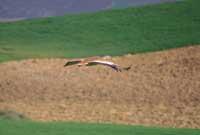
According to experts, in the world there are 28,000 large sketches, of which about 14,000 are in the Iberian Peninsula. Castilla y León and Extremadura welcome 80% of the peninsular sketches. As for the Basque Country, this species is only found in Navarre and is in danger of extinction. Although in the south of Navarre 50 years ago there was a population close to 200 specimens, there are currently only 20 specimens. Although for a few years there has been a slight upturn (in 1982 there were only 10 specimens), any decrease could cause the disappearance of this small population.
These last specimens can be found in the surroundings of Lerín, Miranda de Arga and Bardenas, but it is not easy to see them. And they try to be far from the roads and people, and want to be in the quieter places. Its greatest risks are the waterings, the proliferation of asparagus crops, the scarcity of fallows, illegal hunting and the abuse of chemicals. However, this year a group of researchers has begun to analyze the viability of the Navarre population and it is possible that it will begin to introduce specimens coming from abroad to strengthen the population and remove it from risk. So be it!

Gai honi buruzko eduki gehiago
Elhuyarrek garatutako teknologia



